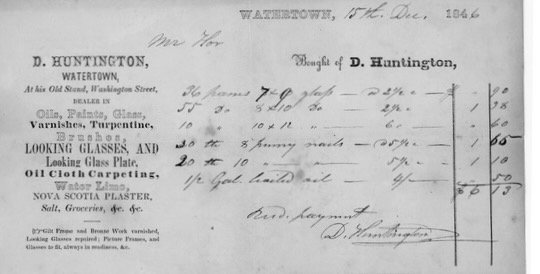Elijah Horr House - a great-great-great granddaughter's discovery
Recently, I have been going through old family papers, among them some belonging to my great-great-great grandfather Elijah Horr and his wife, Betsy Stiles Horr, in Stone Mills. Their house still stands cozily nestled in among old trees. In 1996, I wrote the nomination for this house for the National Register of Historic Places. Judging from known dates of neighboring buildings and from the 1940s research of indefatigable Watertown Daily Times reporter David Lane, I guessed that the Elijah Horr House was built around 1835. But among these family papers, recently donated to the Manuscript Division of the Library of Congress, is a deed for the sale of land signed by John LaFarge and dated March 25, 1837.
Deed for sale of land by John LaFarge to Elijah Horr, 1837.
The land purchased by Elijah Horr was originally part of Penet’s Square, a ten-by-ten mile tract notoriously populated by squatters. The land had allegedly been a gift to Pierre Penet by the Oneidas in return for some favors Penet had done for them. John LaFarge, friend and business partner of Penet in running the French-English blockade in the Caribbean, inherited or took over this land in 1817, evicting the squatters and buying up clear titles to the land. When the town was set off from the Town of Brownville in 1821, LaFarge named it Orleans, denoting, I believe, his loyalty to Louis-Philippe, Duc d’Orléans, known as the “Citizen King” of France, and set to work building up Log Mills, now renamed LaFargeville.
Bill from D. Huntington, Washington Street, Watertown to Mr. Hor (Elijah Horr), December 1846.
David Lane writes that Elijah Horr purchased land from LaFarge as early as 1834 but this contract, dated 1837, is the only deed among Horr’s numerous papers. Another item, a receipt from the hardware dealer and grocer D. Huntington on Washington Street in Watertown, tells us that Horr purchased 91 window panes on December 15, 1846. My romantic imagination leads me to think that Elijah gave these windows to Betsy for Christmas with the promise that the house would be finished and that they could move in in the spring. Perhaps the smallest ones were planned for the fanlight and sidelights that originally framed the main door of the house. At any rate, the constuction date for the Elijah Horr House seems really to be closer to 1845 than to 1835.
Claire Bonney, author of French Emigré Architecture in Jefferson County, New York, 2015.

